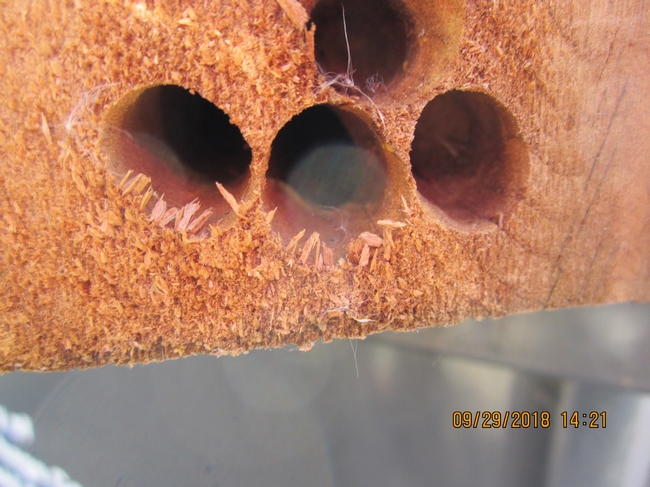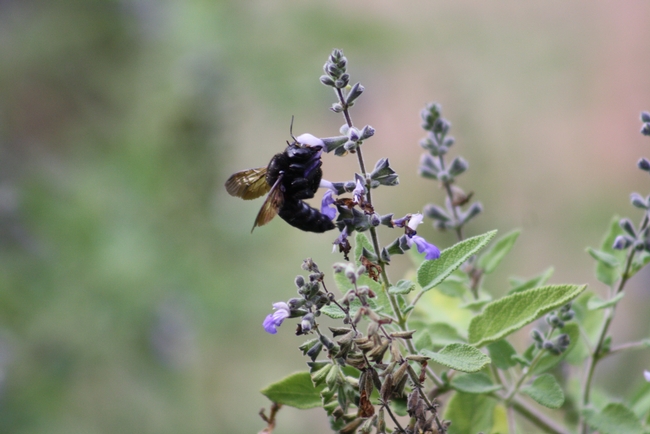The Bee and the Deck
Once upon a time, a couple living in Suisun City built a really big (25 feet X 20 feet) deck behind their house. They chose redwood because of its beauty and its reputation for lasting a long, long time. Years came and went until 25 years later, that beautiful deck had become a pitted, rather dilapidated surface with the boards warping and the screws coming up. Sigh, it was time to replace or tear it down. The couple thought long and hard as to what to do: tear it down, replace the decking with more redwood OR use one of the newer composite decking materials.
In the meantime, over the years critters had made their homes both under the deck and INSIDE it. When conditions were just right, a loud humming could be heard – who OR what was it? Incidentally, a large black bug (huge actually according to the man of the house – an Eagle Scout who was not crazy about insects, bugs, or flying thingies at all) kept “dive bombing” him when he was standing by the steps down from the deck to the patio! “Help! Kill it!” was his cry. The woman, a Master Gardener never saw anything. But wait . . .
Once she was standing on the patio when a large, very large, black bee came flying by; watching, she saw the insect disappear between the patio and deck. Using a flashlight, she checked around and saw nothing. The insect hadn't even indicated her presence as she was there, just standing and watching. Checking her insect field guide, she identified the insect as a California Carpenter Bee with an average size of between ¾ inch and 1 inch. “Cool”, she thought, “Someone new to the yard”. But wait . . .
Later a year later, she was again standing on the deck when she felt a very strong vibration below her feet and heard some loud humming! What the?? Now it was neither cool NOR too funny, especially now that there was a “whole herd” of these giant bees so close to the back door. Now a little information about these critters:
Carpenter bee females bore into sound or sometimes decaying wood to make their nests. Unlike honey bees and others, the carpenter bees are solitary bees. Their nests are usually tunneled ½ inch in diameter and 6 to 10 inches deep in the wood; the nest has partitions making several chambers; each one of these chambers has 1 egg and a food supply of pollen. Sometimes these tunnels are used many times and, at other times, used only once. Several bees will occasionally use the same tunnel, and over time these tunnels can extend up to 10 feet in the wood! After the brood's larval and pupal stages are through, the tunnels are then abandoned with the new adults emerge in late summer to feed on nectar and pollen and over-winter back in the tunnels which have been provisioned with pollen. They then come out in spring to mate and start the cycle anew. There is only 1 generation or brood a year.
Back to the deck building: as the couple carefully took the deck apart, they looked for those big bees – and found none! There were no “spare” holes in the decking boards or in the joists or in the support beams! Where did the humming and vibrations come from' a dream perhaps due to lots of yard work in the hot sun?
The proof that carpenter bees had been chomping nests came when the steps from deck to patio level were removed! There at the back of the risers were a trio of beautifully made ½ inch round holes. Not realizing that someone might still be home, the risers were tossed about 5 feet away from the work area and 1 cracked open. Picking it up, a large leathery-looking pupa squirmed at the broken end of one hole and was probably wondering who turned the lights on! Sorry, little guy! With the riser put upright in a secluded spot away from the “elements”, we hoped he/she would be all right and could continue its transformation and continued replacing everything part of the structure except the beams and rim-joists.
By using pressure-treated wood for the sub-structure and a composite for the decking, the carpenter bees will not find the new decking tasty enough to bore into! If you find carpenter bees in your yard, not to worry about stings; the males cannot sting and the females will not sting unless provoked or handled roughly. Except for their “carpentry work”, these bees make good additions to the yard and are great pollinators.
They like to use the wood from the southern yellow pine, white pine, California redwood, cedar, Douglas fir, cypress, mimosa, mulberry, ash, and pecan trees. Please note that they like the dead wood and not the living tree. For more information, please read the UC ANR Publication 7417, listed under the pest notes section.

Holes in wood. (photo by Betsy Buxton)

Carpenter bee female.


Posted by Kathy Klobas on November 15, 2018 at 3:00 PM